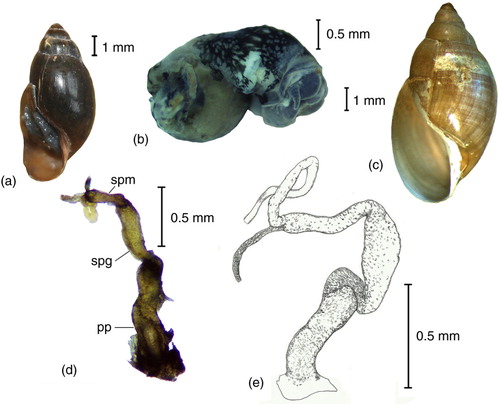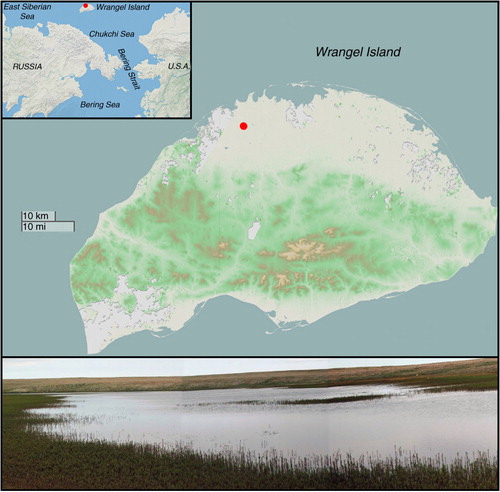Abstract
The first finding of a freshwater snail, Sibirenauta sibiricus (Westerlund, 1877), in one of the lakes on Wrangel Island (north-eastern Russia) is reported. No freshwater mollusc species have hitherto been known from this island. Specimens from the island are morphologically compared with the type series of the species. How aquatic molluscs may have migrated to the Arctic island is briefly discussed.
The malacofauna of large islands belonging to the Eurasian sector of the Arctic has been studied since the second half of the 19th century (Stuxberg Citation1887; Westerlund Citation1887; Smith Citation1896). Most publications have been devoted to marine species (e.g., Stuxberg 1887) though freshwater molluscs are also present in the Arctic island fauna. Usually, the freshwater malacofauna of these islands is believed to be extremely poor though some archipelagos may maintain relatively rich communities of snails and bivalves. For instance, at least 19 species occur in the waterbodies of the Solovetskiy Archipelago (Bespalaya et al. Citation2009); 11 species of molluscs are registered on Vaigach Island (Leško et al. Citation2008) and so on. As a general rule, the farther an island is from the mainland the fewer species of molluscs it houses. Only three species of pulmonate gastropods were found in the Kolguev Island (Smith 1896), and a single species of fingerclams, Pisidium conventus Clessin, 1877, was reported from the Novaya Zemlya Archipelago (Odhner Citation1923; Sidorov Citation1925). The northernmost islands seem to lack freshwater malacofauna altogether, as exemplified by the archipelago of Svalbard (Coulson Citation2007).
The freshwater fauna of Wrangel Island (north-east Russia) was also thought to include no molluscs. Though the island's freshwater habitats are home to several tens of invertebrate species, neither snails nor bivalves have been registered there (Stišov Citation2004). The aim of this note is to discuss the first finding of freshwater snails on Wrangel Island and possible routes of aquatic mollusc migration from the mainland to this island.
Material and methods
Off the coast of north-eastern Eurasia, Wrangel Island is situated at 71°N and is bounded by the Arctic Ocean, East Siberian Sea and Chukchi Sea. Its total area is about 7600 km2. The dominating landscape is Arctic tundra. Aquatic molluscs were collected during a hydrobiological survey of freshwater habitats made by one of us (AN) in 2013. Living snails were found on 19 July 2013 in a nameless lake situated in the Akademiya tundra on the northern edge of the island with these geographical coordinates: 71°28′17.3″ N 179°47′12.0″ W (). No molluscs were found in other studied habitats of the island.
The lake is nearly 500 m long and 10 m wide. The depth of the lake does not exceed 1 m. The water temperature in the sampling site was +14°C, with a pH of 8.2 and ppm (NaCl) of 84. After collection, specimens were fixed in ethanol. Their taxonomic identification was carried out in the laboratory. Measurements and dissections of the snails were made using standard techniques. Six standard measurements with accuracy to the nearest 0.1 mm were taken from 10 shells (see Supplementary Fig. S1): shell height (SH), shell width (SW), aperture height (AH) and width (AW), spire height (SpH) and body whorl height (BWH). The whorl number was also counted.
Results and discussion
The abundance of gastropods and other benthic invertebrates in the studied water body was very low. In total, merely 13 specimens of snails were collected. All the gastropods collected in the lake belong to the same species: Sibirenauta sibiricus (Westerlund 1877), from the pulmonate family Physidae Fitzinger, 1833. This identification was confirmed by comparing our specimens with the lectotype of S. sibiricus designated by CitationVinarski et al. (2013). The type locality of S. sibiricus (Jenissei, Sopotchnaya Korga, 71°40'N, Taimyr Peninsula) is situated in the northern part of Middle Siberia, and its range covers the northern parts of Middle and East Siberia as well as the Chukotka Peninsula and Alaska (Starobogatov & Budnikova Citation1976; Taylor Citation2003; Vinarski et al. Citation2013). Almost all the snails we collected on Wrangel Island were juvenile. The largest shell reaches only 7.7 mm in height, which is less than the height of the holotype shell, 8.8 mm (, ). The morphology of the copulatory organ of the studied specimens corresponds with the morphological description of the genus Sibirenauta Starobogatov et Streleckaja, Citation1967 published elsewhere (Starobogatov & Streleckaja Citation1967; Starobogatov & Budnikova Citation1976; Taylor Citation2003). The preputium is oblong and relatively narrow; the penis sheath is bipartite, divided into glandular and muscular parts (see c), which differentiates Sibirenauta from representatives of the conchologically similar genus Aplexa Fleming, 1820, which is characterized by a unipartite penis sheath (Taylor Citation2003).
Fig. 2 (a) An intact specimen of Sibirenauta from Wrangel Island. (b) Soft body of a snail withdrawn from its shell. (c) Shell of the lectotype of S. sibiricus. (d)–(e) The copulatory organ of Sibirenauta from Wrangel Island (photographs and drawing). The following terms are abbreviated: preputium (pp); glandular portion of penis sheath (spg); muscular portion of penis sheath (spm).

Table 1 Morphometric characteristics of shells of Sibirenauta sibiricus from Wrangel Island: shell height (SH), shell width (SW), aperture height (AH) and width (AW), spire height (SpH) and body whorl height (BWH). See Supplementary Fig. S1 for an explanation of the measurements
The macrozoobenthos community of the lake included, in addition to S. sibiricus, Mesostoma sp. (Turbellaria), Branchinecta paludosa (O.F. Müller 1788) (Branchiopoda), Psectrocladius sp. (Chironomidae), and several species of water mites (Hydrachnidia). Three species of planctonic crustaceans were also found: Heterocope borealis (Fischer 1851), Diaptomus glacialis Lilljeborg, 1881, and Eurycercus cf. glacialis Lilljeborg, 1887.
Two possibilities may explain the fact that Sibirenauta has not previously been documented from the island water bodies. The first one is that this species is extremely rare, so preceding researchers overlooked it. The second possibility is that the snails are rather recent arrivals to Wrangel Island, and we observed the first step of colonization of this land by molluscs. Though it is almost impossible to choose one hypothesis over another on the basis of our limited data, how snails may have migrated to the island is worth considering.
The first hypothesis implies that Sibirenauta is an old inhabitant of the island. The island is thought to have become separated from the mainland by 12 000 years BP (Vartanyan et al. Citation1993). The snails found by us could be remnants of the native mainland fauna, alongside such animals as Arctic fox (Vulpes lagopus) and two species of lemmings (Dicrostonyx vinogradovi and Lemmus sibiricus). The snail's absence in the species lists (Stišov Citation2004) would be explained by its small population or by relatively low research efforts made by a previous investigator, or both.
The other hypothesis supposes that some mechanism of distant dispersal of snails over sea must be proposed. The Long Strait, which is about 140 km wide, separates Wrangel Island from Asia. Though rare, cases of birds carrying pulmonate snails on long voyages—exceeding 1000 km—to remote oceanic islands are known (Gittenberger et al. Citation2006; Kappes & Haase Citation2012). Water birds are the only appropriate vectors to transport snails from the mainland, and freshwater snails migrating in this way is well established (Malone Citation1965; Boag Citation1986; Wesselingh et al. Citation1999). A few large species of waterfowl are known to migrate to Wrangel Island from the mainland and to nest here. Snow goose (Anser caerulescens) and brant goose (Branta bernicla) are among these species (Stišov Citation2004), and we suspect that they could be responsible for the snail's arrival to the island. One may assume that air-breathing should facilitate this way of dispersal for physids, which, like other aquatic pulmonate snails, can withstand desiccation and full absence of water.
Supplementary Material
Download PDF (115.3 KB)Acknowledgements
The authors thank A.R. Gruzdev, the director of the Wrangel Island State Nature Reserve, for his help to AN in the fieldwork. The authors also thank Ivan O. Nekhaev (Murmansk), who photographed the S. sibiricus lectotype, and the two reviewers for their valuable comments. This research was partially funded by the Russian Fund for Basic Research (grant nos. 13-04-00148 and 14-04-01236) and the Russian Ministry of Education and Science (project no. 6.1957.2014/к).
References
- Bespalaya Y.V., Bolotov I.N., Zubry N.A. Topical groups of mollusks in the lakes of Bol'shoy Solovetskiy Island (Solovetskiy Archipelago, White Sea, northwestern Russia). Inland Water Biology. 2009; 2: 177–186.
- Boag D.A. Dispersal in pond snails: potential role of waterfowl. Canadian Journal of Zoology. 1986; 64: 904–909.
- Coulson S.J. Terrestrial and freshwater invertebrate fauna of the High Arctic archipelago of Svalbard. Zootaxa. 2007; 1448: 41–58.
- Gittenberger E., Groenenberg D.S.J., Kokshoorn B., Preece R.C. Molecular trails from hitch-hiking snails. Nature. 2006; 439: 409.
- Kappes H., Haase P. Slow, but steady: dispersal of freshwater molluscs. Aquatic Science. 2012; 74: 1–14.
- Leško Y.V., Fefilova E.B., Baturina M.A., Hohlova L.G. Vodnye bespozvonočnye ostrovov Vaigač i Dolgij. (Aquatic invertebrates of the islands Vaigach and Dolgiy.) Trudy Komi nauchnogo tsentra UrO Rossiyskoi Akademii Nauk 184. 2008; Syktyvkar: Scientific Centre of the Russian Academy of Sciences in Republic of Komi.
- Malone C.R. Dispersal of aquatic gastropods via the intestinal tract of water birds. The Nautilus. 1965; 78: 135–139.
- Odhner N. Mollusca. Pisidium conventus Clessin (P. Clessini Surbeck, partim). Report of the scientific results of the Norwegian Expedition to Novaya Zemlya 6. 1923; Kristiania: Brøgger.
- Sidorov S.A. K voprosu o presnovodnyh molljuskah roda Pisidium na Novoj Zemle. (To the question of freshwater molluscs of the genus Pisidium on Novaya Zemlya.). Trudy Plovuchego Morskogo Nauchnogo Instituta. 1925; 12: 103–104.
- Smith E.A. On some fresh-water shells from the island of Kolguev. Proceedings of the Malacological Society of London. 1896; 2: 104.
- Starobogatov Y.I., Budnikova L.L. O faune presnovodnyh bryukhonogih molljuskov krainego severo-vostoka. Presnovodnaja fauna Čukotskogo poluostrova. (On the fauna of fresh-water gastropod molluscs of the USSR Far North-East. Fresh-water fauna of the Chukchi Peninsula.) Trudy Biologo-Pochvennogo Instituta, new series 36. 1976; Vladivostok: Institute of Biology and Pedology, Far East Science Center, USSR Academy of Sciences.
- Starobogatov Y.I., Streleckaja E.A. Sostav i zoogeografičeskaja harakteristika presnovodnoj malacofauny Vostochnoj Sibiri i severa Dal'nego Vostoka. Molljuski i ih rol’ v biocenosah i formirovanii fauny. (Molluscs and their role in biocoenoses and formation of faunas. Composition and zoogeographical characteristics of freshwater malacofauna of the East Siberia and northern part of the Far East.). 1967; Leningrad: Nauka. Trudy Zoologicheskogo Instituta AN SSSR 42.
- Stišov M.S. Ostrov Wrangelja—etalon prirody i prirodnaja anomalija. (Wrangel Island—the Nature's etalon and natural anomaly.). 2004; Yoshkar-Ola: Marijskij Poligrafkombinat.
- Stuxberg A. Faunan på och kring Novaja Semlja. Vega-Expeditionens Vetenskapliga Iakttagelser 5. (The fauna in and around Novaya Zemlya. Scientific Results of the Vega Expedition 5.). 1887; Stockholm: Bejer.
- Taylor D.W. Introduction to Physidae (Gastropoda: Hygrophyla): biogeography, classification, morphology. 2003; San Pedro Montes de Oca: University of Costa Rica. Revista de Biología Tropical 5, Suppl. 1.
- Vartanyan S.L., Garutt V.E., Sher A.V. Holocene dwarf mammoths from Wrangel Island in the Siberian Arctic. Nature. 1993; 362: 337–340.
- Vinarski M.V., Nekhaev I.O., Glöer P., von Proschwitz T. Type materials of freshwater gastropod species described by C.A. Westerlund and accepted in current malacological taxonomy: a taxonomic and nomenclatorial study. Ruthenica. 2013; 23: 79–108.
- Wesselingh F.P., Cadée G.C., Renema W. Flying high: on the airborne dispersal of aquatic organisms as illustrated by the distribution histories of the gastropod genera Tryonia and Planorbarius. Geologie en Mijnbouw. 1999; 78: 165–174.
- Westerlund C.A. Land- och Sötvatten-Mollusker insamlade under Vega-Expeditionen af O. Nordqvist och A. Stuxberg. Vega-Expeditionens vetenskapliga iakttagelser 4. (Land and freshwater molluscs collected during the Vega Experdition by O. Nordqvist and A. Stuxberg. Scientific Results of the Vega Expedition 4.). 1887; Stockholm: Bejer.

